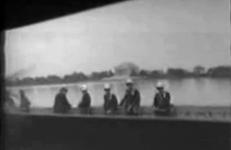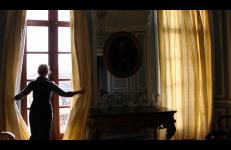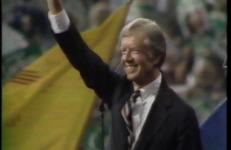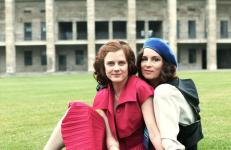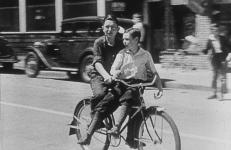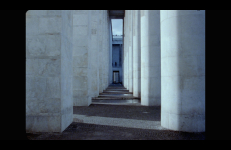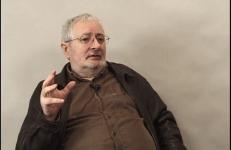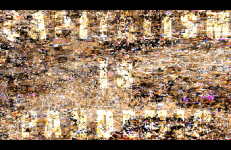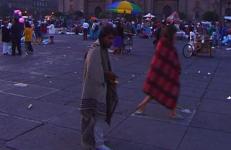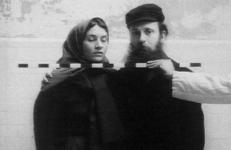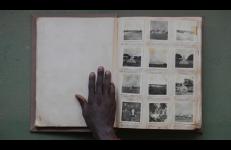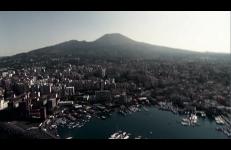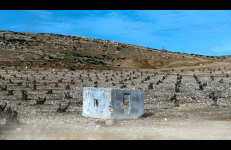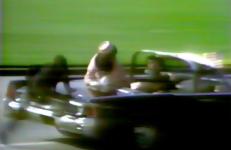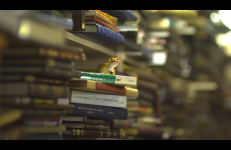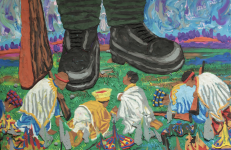The Cyan Garden considers the limits of giving form to the past which cannot cohere into memory. In part filmed on ‘Lucky', a discontinued b&w 16mm film reel stock intended for military aerial detection, the film revolves around a radio station that was not supposed to be detected and an Airbnb apartment ‘The Lover’, run by the artist’s friend in their hometown. Between 1969 and 1981, a Malaysian communist underground radio in exile Voice of the Malayan Revolution resided in what is now soon to be a resort.
History
Fifty years after the Cultural Revolution in China, two elderly Chinese women recite the propaganda songs they learn at the educational camps.
Footage from the May Day 1971 events in Washington DC. Davidson, a Videofreex member, gets arrested, and what follows is rarely seen footage of the inside of the detainment bus and the jail cell, videotaped by an arrestee.
The house in the film is Maison de l'Armateur, "the ship owner's house", one of the few houses in Le Havre, France that remained in tact after the city was completely destroyed in the allied bombings of D-Day, 1944. The work deals with the desire to preserve and organize objects, and by doing so, to tell a specific historical tale. It also deals with nostalgia to a world that no longer exists, and perhaps never did.
Appropriated network-TV footage of Jimmy Carter’s "I see risk" speech from the 1980 Democratic Convention meets Reagan’s gloomy inaugural ride through D.C.: "If you succumb to a dream world, you’ll wake up to a nightmare."
This title is also available on Presidents and Elections.
1933. Berlin. The last year of the Wiemar Republic. Through the lense of her personal "home movies", Leni Riefenstahl records a day in her life with a young Eva Braun.
Die Neue Frau is the third film in the The Surface Tension Trilogy, a three-part short film trilogy looking at queer artists living in Berlin during the 1920s. Shot on hand-processed 16mm film.
Executive produced by Sara Diamond at the Banff Art Centre, co-produced by Michelle Baughn and Suzanne Lacy, directed by Tom Weinberg and Dick Carter, and edited by Holen Kahn.
The Disappointment: Or, The Force of Credulity is a documentary about the search for four lost treasures buried on a single farm in Missouri. These treasures include a Spanish explorer's gold, silver from the Civil War, mysterious stone carvings, lost texts, and a wife's attempt to heal her husband and protect herself and her children. Part personal documentary and part historical essay, The Disappointment traces the patterns of cultural forgetting etched in the landscape of the Austin Farm.
This film uses the ‘old fashioned’ conventions of documentary film practice to stand history on its head. There is a narration taken from a radio lecture by Claude Lévi-Strauss entitled, “The Meeting of Myth and Science,” images from the Deutsche Wochenshau of June 25, 1940 that recorded Hitler’s dawn visit to Paris, images from American newsreels, a movement from one of Beethoven’s Rasumovsky Quartets. The film could only succeed, in my mind, if the imprint of prior usage of all elements was clear.
E42 is a cinematic exploration of the area in Rome knows as the EUR, a modernist landscape that was originally designated by Mussolini as the the site of the World Fair of 1942 and as a celebration of the 20 year anniversary of Fascism. Originally designed as a monumental space for public performance and collective acts of solidarity to the Fascist regime, this landscape was in fact never inaugurated.
In this interview, political and social theorist, Terry Eagleton (b. 1943), shares stories of his Irish upbringing and British education, and sums up his current engagement with art theory, leftist politics, and spirituality under capitalism. With reference to Henry James, Frederic Jameson, Christopher Hitchens, and Richard Dawkins, among others, this interview spans a vast landscape of literature and social theory.
The supposed existence of a golden kingdom motivated numerous expeditions, and the belief remained in force until the 19th century, although its location moved from Colombia to the Guianas, as the process of conquest and colonization of the South American territory progressed. A journey and a drift from extractive colonialism that is far from over.
El Zócalo is an observational portrait of Mexico City’s central Plaza de la Constitutión during one day in August. Soldiers, Aztec dancers, clowns, food vendors, protestors, rain, dogs, tourists, kites, balloons, and dignitaries all meet in the public space of the Zócalo. This documentary presents daily life in one of the largest and most vibrant urban centers in the world, but it begins with a dream of history and ends with a dream of the space full of people for a Zapatista rally.
El Zócalo is an observational portrait of Mexico City’s central Plaza de la Constitutión during one day in August. Soldiers, Aztec dancers, clowns, food vendors, protestors, rain, dogs, tourists, kites, balloons, and dignitaries all meet in the public space of the Zócalo. This documentary presents daily life in one of the largest and most vibrant urban centers in the world, but it begins with a dream of history and ends with a dream of the space full of people for a Zapatista rally.
Between 1892 and 1927, almost 16 million people came to Ellis Island attempting to immigrate to the United States.
Between 1892 and 1927, almost 16 million people came to Ellis Island attempting to immigrate to the United States.
The Embassy deals with the codes of representation used by the former Portuguese colonial power over the West African country Guinea-Bissau, and with modes of memory production. It shows a photo album depicting the perspective of the Portuguese colonist, who photographed with documentary diligence landscapes, people, architecture and monuments in Guinea-Bissau in the 1940s and 1950s.
"Living on the slopes of the volcano Vesuvius is a strange contradiction: always in stress and yet also sleepy, waiting for what might happen. In close cooperation with the Osservatorio Vesuviano and several inhabitants of the 'Red Zone' of the volcano, Rosa Barba constructs a lyrical portrait of this area, which shelters Mafia members and illegal Chinese immigrants. Historic footage, measurements, maps, and aerial shots try to capture what is always uncertain."
The project presents the blurring of the Green Line for Israelis and its consolidation for Palestinians, through important planning and legal decisions.
Irreverent yet poignant, The Eternal Frame is a re-enactment of the assassination of John F. Kennedy as seen in the famous Zapruder film. This home movie was immediately confiscated by the FBI, yet found its way into the visual subconscious of the nation. The Eternal Frame concentrates on this event as a crucial site of fascination and repression in the American mindset.
"The intent of this work was to examine and demystify the notion of the presidency, particularly Kennedy, as image archetype...."
— Doug Hall, 1984
Irreverent yet poignant, The Eternal Frame is a re-enactment of the assassination of John F. Kennedy as seen in the famous Zapruder film. This home movie was immediately confiscated by the FBI, yet found its way into the visual subconscious of the nation. The Eternal Frame concentrates on this event as a crucial site of fascination and repression in the American mindset.
"The intent of this work was to examine and demystify the notion of the presidency, particularly Kennedy, as image archetype...."
— Doug Hall, 1984
Irreverent yet poignant, The Eternal Frame is a re-enactment of the assassination of John F. Kennedy as seen in the famous Zapruder film. This home movie was immediately confiscated by the FBI, yet found its way into the visual subconscious of the nation. The Eternal Frame concentrates on this event as a crucial site of fascination and repression in the American mindset.
"The intent of this work was to examine and demystify the notion of the presidency, particularly Kennedy, as image archetype...."
— Doug Hall, 1984
A woman recounts her story of the mass exodus of Palestinians from Jerusalem. Beginning with the arrival and ending with the departure, the tale moves backwards in time and through various landscapes. The events are neither undone nor is the story untold; instead, Farther than the eye can see traces a decaying experience to a place that no longer exists.
Based on live testimony, historical documents from my Egyptian Jewish family’s archives, and fragments from the renowned Cairo Geniza discovered in the 19th century in the Ben Ezra synagogue in Cairo, which includes documents from the 9th-19th centuries. Fatherland Archives illuminates the vanished world of Egyptian Jewish life and culture.
Inspired by an unaccomplished personal project, in this animation, I’m exploring ideas of intention, extension, and failed romanticism. I used images and texts from mass-produced postcards, packaging, calendar booklets, books, posters, and pamphlets that were created and used as political propaganda devices for the invasion of Ethiopia by Fascist Italy during WWII. Some of these prints were on the front covers of school notebooks, some were games that taught the geography, history, and natural resources of Ethiopia.






